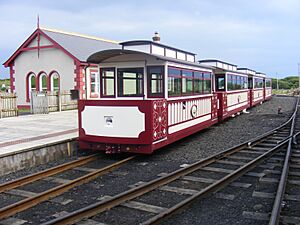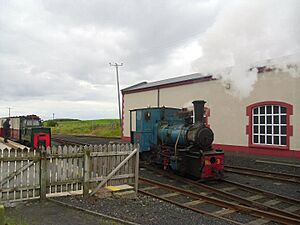Giant's Causeway and Bushmills Railway facts for kids
The Giant's Causeway and Bushmills Railway (GC&BR) is a special narrow gauge heritage railway. It runs between the famous Giant's Causeway and the town of Bushmills on the coast of County Antrim, Northern Ireland. This fun railway line is about two miles (3.2 km) long.
Contents
History of the Railway
The First Electric Tramway
The original Giant's Causeway Tramway was a very important railway. It was run by the Giant's Causeway, Portrush and Bush Valley Railway & Tramway Company Ltd. This 3 ft (914 mm) narrow gauge electric railway connected Portrush to the Giant's Causeway. It was 9+1⁄4 miles (14.9 km) long.
When it opened, people called it "the first long electric tramway in the world." This was a big deal! It first opened to Bushmills in 1883. Then, it was extended to the Causeway on July 1, 1887. The tramway used hydroelectricity (power from water) to run. It closed down at the end of the 1949 season on September 30. After that, the tracks were taken apart.
Bringing the Railway Back
The idea for the new railway came from David Laing. He wanted to use equipment that Lord O’Neill had collected for a tourist line at Shane's Castle. That line had closed in 1994.
The Giant's Causeway and Bushmills Railway Company is a group that doesn't make a profit. They are a charity. Work to clear the old track started in late 1999. The railway carried its first passengers at Easter in 2002.
On July 10, 2010, the railway got a new train. It was a special 4-coach diesel train. It can carry up to 90 passengers. This new train helps visitors enjoy the North Antrim Coast even more. It also helps to bring back the feeling of the old electric tram. The new train started running on July 15, 2010. It shares the tracks with the older steam trains.
Exploring the Route
The railway journey starts at the upper station. This station is just below the Causeway Hotel. It has one platform and buildings that look like old railway stations.
The train leaves the station and goes down a hill towards Bushfoot Strand. The hill is steep enough to make the engines work hard on the way back up! The line then follows the old sand dunes. It crosses the River Bush on a new bridge. There is a special section of track called a passing loop just before the bridge, but it is not used very often.
After crossing Bushfoot Golf Course, the line meets Ballaghmore Road. This road goes from Bushmills to Portballintrae. The railway then runs next to this road. It ends at the lower station in Bushmills. This station has one platform but no buildings. You can also find a cycle track (National Cycle Network 93) and a footpath right next to the railway line.
Our Locomotives and Coaches
The railway has several engines, called locomotives, and passenger cars, called coaches.
| No. | Name | Type | Builder | Built | Notes |
|---|---|---|---|---|---|
| 1 | Tyrone | Steam engine | Peckett and Sons | 1904 | Used to work for British Aluminium Co. |
| 2 | Rory | Diesel engine | Simplex | 1976 | Used to work for Blue Circle Cement |
| 3 | Shane | Steam engine | Andrew Barclay & Sons Co. | 1949 | Used to work for Bord na Móna, built to burn peat |
Here are some notes about the engines:
- OC: This means the steam engine has its cylinders (the parts that make it move) on the outside.
- WT: This stands for "Well Tank." It's a type of steam engine that carries its water in a tank built into the frame of the engine.
- DH: This means it's a Diesel engine that uses Hydraulic Transmission to move.
The railway also has eight coaches. These are the cars where passengers sit. Each coach has four wheels.




